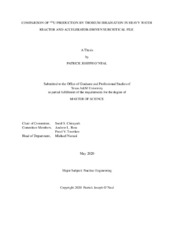| dc.description.abstract | The purpose of this research was to compare the viability of producing uranium-233 (²³³U) using two oft-overlooked methods of fertile isotope transmutation: a heavy water moderated reactor and an accelerator-driven system. This type of investigation can be helpful in evaluating not only the capabilities available to a potential proliferator, but also indicate to regulators possible vulnerabilities that exist within the current safeguards regime. The impetus behind the selection of the two production methods was their ability to avoid many of the most heavily safeguarded methods and materials, while ²³³U was chosen due to the global prevalence of thorium.
A scoping analysis was performed to identify benchmarks to judge the effectiveness of each transmutation method. These benchmarks were based off of several pragmatic critical masses that were found using Monte Carlo neutron transport simulations. These critical masses had variation in material properties and geometric configurations, which established a range of material production quantities to compare between. A Monte Carlo N-Particle (MCNP) model of the National Research Experimental (NRX) reactor was used to determine the optimal place to irradiate thorium targets. That same model was then modified to include the thorium targets, and fuel burnup calculations were conducted to determine the mass of ²³³U that could be produced in 2 years. It was found the NRX reactor was capable of producing 2.79 kg in two years, with a contamination of 10.1 ppm ²³²U. Next, a model of an accelerator-driven system (ADS) was created using characteristics found in open literature. The optimal placement of thorium irradiation targets was found, and a two year fuel burnup calculation was conducted. The ADS was capable of producing 5.76 kg by the end of the two year period, although this large advantage in material production quantity was primarily because more thorium was able to be loaded around the neutron spallation source of the ADS than in the J-rod annulus of the NRX reactor. The material produced via the ADS also had no ²³²U contamination.
While there were several factors that would impede a proliferator that were not included in this analysis, such as material losses from milling, metal conversion, target fabrication, and post irradiation isotope separation, this analysis presents some of the ways that a determined state could take advantage of portions of nuclear science that the safeguards community is not focusing heavily on. The current IAEA material safeguards significant quantity (SQ) for thorium is 20 tons, well above the amount of thorium needed to produce a critical mass worth of ²³³U using both these production methods. One current factor that helps marginally protect against these production methods is that both methods require certain items that are closely monitored due to their status as dual-use technology items. | en |


